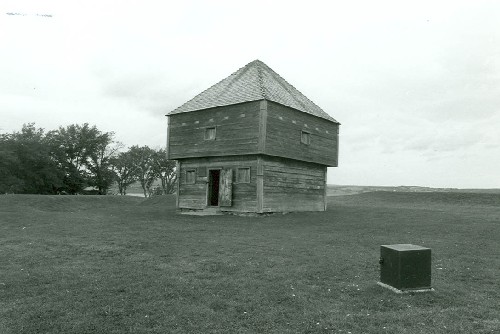Other Name(s)
Fort Edward National Historic Site of Canada
Fort Edward
Fort Edward
West Point Blockhouse
West Point Blockhouse
Links and documents
Construction Date(s)
1750/01/01
Listed on the Canadian Register:
2007/05/23
 Statement of Significance
Statement of Significance
Description of Historic Place
Fort Edward NAtional Historic Site of Canada comprises a wooden blockhouse as well as remnants of buildings and landscape features from an 18th century fortification on the outskirts of Windsor Nova Scotia where the St. Croix River joins Pesaquid Lake. The official recognition refers to the only surviving structure from the fort, the blockhouse.
Heritage Value
Fort Edward was designated a national historic site of Canada for:
- the role it played in the struggle for predominance in North American from 1750 to the War of 1812, which includes,
- the French-English-Aboriginal struggle for predominance during and after the Seven Years War,
- the Deportation of the Acadians,
- local defence during the American Revolution and the War of 1812.
The heritage value of Fort Edward National Historic Site of Canada lies in its illustration of the British presence during this struggle, specifically as expressed in the surviving cultural landscape of the fortress. Fort Edward was built by Major Charles Lawrence of the British Army in 1750 and originally consisted of a number of wooden buildings set inside a palisaded square with four bastions, ramparts, a ditch, a counterscarp and glacis. Its buildings included a blockhouse, two barracks and a provisions storehouse. Fort Edward was transferred to national historic sites in 1922. Its blockhouse has been restored and opened for visitation.
Source: Historic Sites and Monuments Board of Canada, Minutes, July 1995.
Character-Defining Elements
Key elements contributing to the heritage value of this site include:
- the siting of the blockhouse with the cultural landscape of Fort Edward, still legible as a British fort with star-shaped ramparts and blockhouse;
- the strategic location of the site at the confluence of St. Croix River and Pesaquid Lake;
- the Blockhouse with its square massing, tripartite design with squat lower storey, overhanging upper storey, and pyramidal roof, its articulation as a defensive structure with sparse door and window openings and plentiful gun slits, its surviving original materials and craftsmanship;
- its location in relation to other built and landscaped components of the fort,
- viewplanes to the St. Croix River and Pesaquid Lake.
 Recognition
Recognition
Jurisdiction
Federal
Recognition Authority
Government of Canada
Recognition Statute
Historic Sites and Monuments Act
Recognition Type
National Historic Site of Canada
Recognition Date
1920/01/30
 Historical Information
Historical Information
Significant Date(s)
1750/01/01 to 1812/01/01
1922/01/01 to 1922/01/01
Theme - Category and Type
- Governing Canada
- Military and Defence
Function - Category and Type
Current
- Leisure
- Museum
Historic
- Defence
- Military Defence Installation
Architect / Designer
n/a
Builder
n/a
 Additional Information
Additional Information
Location of Supporting Documentation
National Historic Sites Directorate, Documentation Centre, 5th Floor, Room 89, 25 Eddy Street, Gatineau, Quebec
Cross-Reference to Collection
Fed/Prov/Terr Identifier
318
Status
Published
Related Places

Blockhouse
The Blockhouse at Fort Edward National Historic Site of Canada is a compact two-storey wood structure with an overhanging second floor and pyramidal roof clad in wood shingles.…